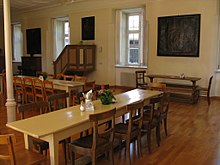Table reading

A table reading (Latin: collatio ad mensam ) is the reading of literature over a meal. Its roots in Christianity go back to late antiquity, an important motif is the Jesus word Mt 4,4 LUT . The table reading was prescribed in some religious rules.
Cyprian already recommended in a letter that psalms should be recited at mealtimes. The transitions to psalm singing and table music are fluid.
Today, restaurants sometimes offer a reading to turn eating into a “culinary and cultural experience”.
Monastic tradition
In Egyptian monasticism, strict silence was observed at meals. The Greek and Latin monastic authors did not adopt this practice. Basil , Cassian and Caesarius of Arles mention the table reading. Augustine interpreted the table reading as spiritual food intake:
“From the beginning to the end of the meal, listen carefully to the usual reading without speaking out loud or protesting the words of the Scriptures. Because you should not only satisfy your hunger with your mouth, but your ears should also hunger for the word of God. "
The Rule of Benedict brings the Egyptian and Western traditions together, the brothers are silent at the table, so that only the reader's voice can be heard (RB 38.1 and 38.5). A sign language was used for communication at the table . While Augustine expected spontaneous reactions to the lecture, Benedict regulated that there should be no questions. The service of the desktop reader is responsible; a separate chapter of the rule is devoted to it.
In late antiquity, patch poems were made from biblical quotations ( Cento ) especially for use as a table reading, so-called “table spice”. “Not only in monastic communities, but also at weddings of lay people and other festive occasions.” The table reading became in the Middle Ages from the monastic sphere taken over at royal courts; A novel could be read during the ritualized courtly feast or after it.
In addition to the Bible, the content of the monastic reading could be a text from monastic literature. The development in male and female monasteries in the late Middle Ages followed different paths. In male monasteries the theological classics were presented in Latin, in women's monasteries traditional prose texts.

In Benedictine monasteries, a section from the Bible is read every day and, according to a yearly plan, a specific section from the Rule of Benedict is read. In addition, different literature can be selected, but it must be suitable for reading aloud in sections. According to a 1992 survey, table reading is practiced in all Benedictine women's monasteries and almost all men's monasteries in Germany at lunch and dinner. According to the same survey, the spectrum ranges from traditional monastic literature to biographies, magazines and fiction.
Reading after eating
In a small and familiar group, a reading is easier to do after dinner than during dinner. It also goes back to Christian late antiquity and is recommended, for example, in the Benedictine Rule.
Web links
- Archabbey of Beuron: Our table readings
literature
- Guido Fuchs: grinding culture. Grace and table ritual. Friedrich Pustet, Regensburg 1998. ISBN 3-7917-1595-X .
Individual evidence
- ^ Cyprian: To Donatus. In: BKV. Retrieved March 2, 2018 .
- ↑ Guido Fuchs: grinding culture . S. 224 .
- ↑ Guido Fuchs: grinding culture . S. 208 .
- ↑ Basil the Great: 313 concise regulations. In: BKV. Retrieved March 20, 2018 .
- ↑ Johannes Cassian: From the facilities of the monasteries. In: BKV. Retrieved March 20, 2018 .
- ^ Rule of Augustine III 2. (PDF) Retrieved on March 21, 2018 .
- ^ Rule of Benedict. In: BKV. Retrieved March 20, 2018 .
- ↑ Christoph Markschies: The ancient Christianity . 2nd Edition. CH Beck, Munich 2012, ISBN 978-3-406-63514-4 , p. 102 .
- ↑ Matthias Däumer: Voice in the room and stage in the head: About the performative potential of the courtly Arthurian novels . Bielefeld 2013, ISBN 978-3-8376-2137-2 , p. 361 .
- ^ Arno Mentzel-Reuters: Arma spiritualia: Libraries, books and education in the Teutonic Order . Harrassowitz, Wiesbaden 2003, ISBN 3-447-04838-7 , pp. 80-81 .
- ↑ Guido Fuchs: grinding culture . S. 211 .
- ^ Rule of Benedict. In: BKV. Retrieved March 20, 2018 .